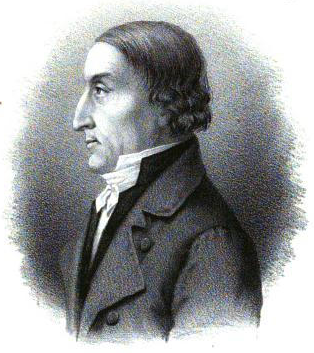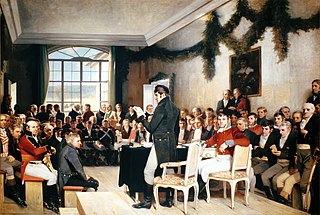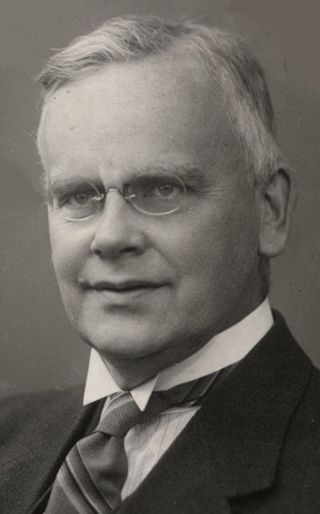Related Research Articles

The University Museum of Bergen is a university museum in Bergen, Norway. The museum features material related to anthropology, archaeology, botany, geology, zoology, art, and cultural history.

Bergen Cathedral School is an upper secondary school in Bergen, Norway. Located in the city centre, next to Bergen Cathedral, the school has about 850 students, 95 full-time teachers, and 5 administration personnel, including the headmaster, Karen Kristine Rasmussen.

Eilert Christian Brodtkorb Christie was a Norwegian architect.

Jonas Rein was a Norwegian priest, poet and member of the Norwegian Constituent Assembly at Eidsvoll in 1814.

The Norwegian Constituent Assembly is the name given to the 1814 constitutional assembly at Eidsvoll in Norway, that adopted the Norwegian Constitution and formalised the dissolution of the union with Denmark. In Norway, it is often just referred to as Eidsvollsforsamlingen, which means The Assembly of Eidsvoll.
Events in the year 1849 in Norway.

Edvard Eilersen Hagerup was a Norwegian solicitor and politician.

Wilhelm Frimann Koren Christie was a Norwegian attorney. He was a member of the National Assembly at Eidsvoll in 1814 and served as the Norwegian Constituent Assembly secretary.

Harald Gram was a Norwegian jurist, politician and genealogist. He was secretary general for the Conservative Party of Norway for 22 years, deputy mayor of Aker, member of Parliament from 1928 to 1936, and stipendiary magistrate in Oslo from 1936 to 1957. He was also noted for his work during World War II.
Carl Fredrik Johannes Bødtker was a Norwegian engineer and radio personality.
Hartvig Caspar Christie was a Norwegian mineralogist and physicist.
Johan Koren Christie was a Norwegian writer. He was a notable nationalist writer in the middle of the nineteenth century.

Werner Hosewinkel Christie was a Norwegian agricultural researcher.

In Scandinavian academia, a doctoral ring or PhD-ring is traditionally bestowed upon the conferral of a doctorate. The tradition goes back to the middle ages, when the ring was supposed to symbolize the bond between the doctor and the sciences.

Wilhelm Frimann Koren Christie was a Norwegian jurist and Nazi collaborator. He is best known as director of the Norwegian Broadcasting Corporation for some time during the occupation of Norway by Nazi Germany.
Eyvind Mehle was a Norwegian radio personality, media professor and Nazi collaborator.
Roald Rachlew Dysthe was a Norwegian businessperson and acquitted Nazi collaborator.
Edvard Sylou-Creutz was a Norwegian classical pianist, composer and radio personality, who was especially active in Nazi-controlled radio in Germany and occupied Norway between March 1940 and the autumn of 1942.

The Jew clause is in the vernacular name of the second paragraph of the Constitution of Norway from 1814 to 1851 and from 1942 to 1945. The clause, in its original form, banned Jews from entering Norway, and also forbade Jesuits and monastic orders. An exception was made for so-called Portuguese Jews. The penultimate sentence of the same paragraph is known as the Jesuit clause.
Peder Carolus Jonsen Fylling, also known as Per Fylling, was a Norwegian folk material collector, book and antique collector, local historian, and author of cultural history books and articles.
References
- ↑ Hemstad, Ruth (2011). Opplysning, vitenskap og nasjon: bidrag til norsk bibliotekhistorie. Oslo: Novus forlag. pp. 159, 261. ISBN 9788270996452.
- ↑ Christie, Wilhelm Frimann Koren (1837). "Fortale, Indhold". Urda. 1: v–viii. Retrieved March 15, 2018.
- ↑ Thuesen, Arthur (1927). Beslaglagte og supprimerte bøker i den norske litteratur. Oslo: Bibliofilklubben. p. 151.
- ↑ "A/S John Grieg Boktrykkeri". Fotomuseum Bedrift. Retrieved March 15, 2018.